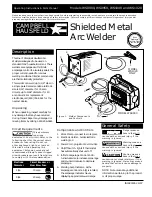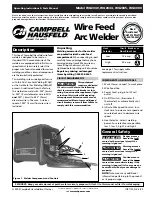
20
5-572.10
START-UP PROCEDURE
Furnaces are supplied with intermittent pilot systems with
continuous retry, which both the main burner and pilot burner
are turned off 100% when the thermostat is satisfied.
Control Options (see page 23) could change the listed
sequence of operation for the unit based on their function. The
descriptions given below are for the basic duct furnace.
Single Furnace Controls
Single furnace units (Model Digits 4-6=75 through 400) are
offered with different types of gas control:
• Staged Control (Model Digit 12=1 or 2):
These furnaces
utilize a single- or two-stage combination gas valve, an
ignition control, and a low voltage thermostat.
• Electronic Modulating Control (Model Digit 12=4, 7, or
8):
These furnaces utilize a single-stage combination gas
valve, an electronic modulating gas valve, a modulating
amplifier, an ignition control, and one of the following:
»
Modulating room thermostat
»
Modulating duct thermostat with remote temperature
set point adjuster
»
Building Management System (BMS) signal by others
(an inverted signal where 0VDC or 4mA is high fire
and 10VDC or 20mA is low fire).
• Electronic Modulating Control with Modine Control
System (Model Digit 12=9):
These furnaces utilize
a single-stage combination gas valve, an electronic
modulating gas valve, a programmable microprocessor
based controller, an ignition control, and different sensors
depending on the application, but most commonly include:
»
A duct temperature sensor
»
A space temperature sensor
»
There is also BMS integration capability for BACnet or
LonWorks protocol systems.
The control operating sequence for all furnaces is as follows:
1. The thermostat calls for heat or is enabled by the BMS.
2. The power exhauster relay is energized starting the
power exhauster motor. Once the motor has reached full
speed, the differential pressure switch closes. The power
exhauster pre-purge time delay relay then closes after 20
to 40 seconds and energizes the gas control circuit.
3. The pilot valve opens and the spark igniter sparks in an
attempt to light the pilot. The system will attempt to light
the pilot for 70 seconds. If the pilot is not sensed for any
reason, the ignition control will wait for approximately
six minutes with the combination gas control closed and
no spark. After six minutes, the cycle will begin again.
After three cycles, some ignition controllers lockout for
approximately one hour before the cycle begins again. This
will continue indefinitely until the pilot flame is sensed or
power is interrupted to the system.
IMPORTANT
To prevent premature heat exchanger failure, with all control
systems, a blower starting mechanism must be provided so
that the blower is running or energized within 45 seconds of
the gas control operation.
Furnace Control Operating Sequence
4. Once the pilot is lit, the flame sensor proves the pilot and
stops the spark igniter from sparking.
5. The main gas valve is opened and the main burner is
controlled as follows:
a.
Single-Stage Furnaces (Model Digit 12=1):
The main
burner is lit to 100% full fire.
b.
Two-Stage Furnaces (Model Digit 12=2):
The main
burner is lit to 50% fire. If the temperature at the
thermostat continues to fall, the thermostat will call for
high stage heat and the main burner is lit to 100% full
fire.
c.
Modulating Room or Duct Thermostat (Model
Digit 12=4):
The main gas valve is opened 100%
and the burner firing rate is modulated between 40%
and 100% full fire. A resistance signal (8000 to 12000
ohms) in the thermostat is converted by the modulating
amplifier to an inverted DC voltage (between 0VDC
for high fire to 12 VDC for low fire) and applied to the
modulating gas valve to control the gas flow to the
main burner.
Note:
When modulating duct sensing is utilized, a
room override thermostat can be added. When the
room override calls for heat, the burner modulates to
full fire operation until the room override is satisfied.
The unit then reverts back to duct sensing control.
When equipped with both, either the duct sensor or
the room override thermostat can call for heat.
d.
BMS Signal (Model Digit 12=7 or 8):
The main gas
valve is opened 100% and the burner firing rate is
modulated between 40% and 100% full fire. A BMS
0-10VDC or 4-20mA signal (inverted, such that 0 VDC
or 4 mA is high fire and 10 VDC or 20 mA is low fire)
is converted by the signal conditioner/modulating
amplifier into an inverted DC voltage (between 0VDC
for high fire to 12 VDC for low fire) and applied to the
modulating gas valve to control the gas flow to the
main burner. The signal conditioner can accept a 0-10
VDC signal when all the dip switches are in the “OFF”
position and 4-20 mA signal when all the dip switches
are in the “ON” position.
Note:
For further information regarding the operation
of any of the electronic modulating system options
above, consult the literature provided with the unit.
e.
Modulating with Modine Control System (Model
Digit 12=9):
The main gas valve is opened 100% and
the burner firing rate is modulated between 40% and
100% full fire. Heating demand is determined by the
Modine Control System through a comparison of the
supply air or space temperature to setpoint and a DC
voltage (between 2VDC for low fire to 10 VDC for high
fire) is applied to the modulating gas valve to control
the gas flow to the main burner.
Note:
Typically the temperature control is via supply
air with the space sensor used to reset the supply air
temperature setpoint. For additional information, refer
to the Modine Control System Manual, literature #74-
510 that shipped with the unit.
6. If the unit was provided with a time delay relay, the blower
starts after 30 to 45 seconds.
7. Once the temperature is satisfied, both the main and pilot
valves close 100%. Blower operation may or may not
continue, depending on application.
















































